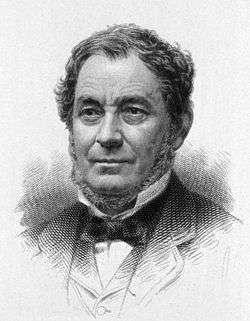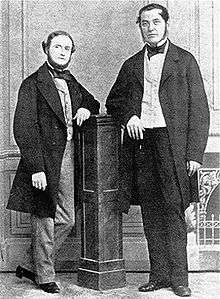Robert Bunsen
| Robert Bunsen | |
|---|---|
 | |
| Born |
Robert Wilhelm Eberhard Bunsen 30 March 1811[N1] Göttingen, Westphalia, Rhine Confederation (now Germany) |
| Died |
16 August 1899 (aged 88) Heidelberg, Baden, German Empire (now Germany) |
| Residence | Germany |
| Fields |
|
| Institutions |
|
| Alma mater | University of Göttingen |
| Doctoral advisor | Friedrich Stromeyer |
| Doctoral students | |
| Known for | Discovery of cacodyl radical; discoveries of caesium and rubidium. Invention of the Bunsen burner; carbon-zinc electrochemical cell; methods of gas analysis; development of spectrochemical analysis |
| Notable awards |
|
Robert Wilhelm Eberhard Bunsen (30 March 1811[N1] – 16 August 1899) was a German chemist. He investigated emission spectra of heated elements, and discovered caesium (in 1860) and rubidium (in 1861) with the physicist Gustav Kirchhoff. Bunsen developed several gas-analytical methods, was a pioneer in photochemistry, and did early work in the field of organoarsenic chemistry. With his laboratory assistant, Peter Desaga, he developed the Bunsen burner, an improvement on the laboratory burners then in use. The Bunsen–Kirchhoff Award for spectroscopy is named after Bunsen and Kirchhoff.
Early life and education
Robert Bunsen was born at Göttingen in 1811, in what is now the state of Lower Saxony in Germany. Bunsen was the youngest of four sons of the University of Göttingen's chief librarian and professor of modern philology, Christian Bunsen (1770–1837).[1] Sources disagree on Robert Bunsen's exact birth date. His parish register, as well as two curricula vitae handwritten by Bunsen himself, support the claim that 30 March 1811 is Bunsen's true birth date;[2][3][4][5] however, many later sources cite 31 March as the date.[1][6][7][8][9][10] According to his biographer Georg Lockemann, Bunsen himself celebrated his birthday on the 31st in his later years. Lockemann nevertheless regarded the 30th as the correct date.[5]
After attending school in Holzminden, Bunsen matriculated at Göttingen in 1828 and studied chemistry with Friedrich Stromeyer as well as mineralogy with Johann Friedrich Ludwig Hausmann and mathematics with Carl Friedrich Gauss.[1] After obtaining a PhD in 1831, Bunsen spent 1832 and 1833 traveling in Germany, France, and Austria; Friedlieb Runge (who discovered aniline and in 1819 isolated caffeine), Justus von Liebig in Giessen, and Eilhard Mitscherlich in Bonn were among the many scientists he met on his journeys.[1]
Academic career
In 1833 Bunsen became a lecturer at Göttingen and began experimental studies of the (in)solubility of metal salts of arsenous acid. His discovery of the use of iron oxide hydrate as a precipitating agent is still today the most effective antidote against arsenic poisoning. This interdisciplinary research was carried on and published in conjunction with the physician Arnold Adolph Berthold.[11][12] In 1836, Bunsen succeeded Friedrich Wöhler at the Polytechnic School of Kassel. Bunsen taught there for three years, and then accepted an associate professorship at the University of Marburg, where he continued his studies on cacodyl derivatives. He was promoted to full professorship in 1841. While at University of Marburg, Bunsen participated in the 1846 expedition for the investigation of Iceland's volcanoes.[13]
Bunsen's work brought him quick and wide acclaim, partly because cacodyl, which is extremely toxic and undergoes spontaneous combustion in dry air, is so difficult to work with. Bunsen almost died from arsenic poisoning, and an explosion with cacodyl cost him sight in his right eye. In 1841,[14] Bunsen created the Bunsen cell battery, using a carbon electrode instead of the expensive platinum electrode used in William Robert Grove's electrochemical cell. Early in 1851 he accepted a professorship at the University of Breslau, where he taught for three semesters.

In late 1852 Bunsen became the successor of Leopold Gmelin at the University of Heidelberg. There he used electrolysis to produce pure metals, such as chromium, magnesium, aluminum, manganese, sodium, barium, calcium and lithium. A long collaboration with Henry Enfield Roscoe began in 1852, in which they studied the photochemical formation of hydrogen chloride (HCl) from hydrogen and chlorine. From this work, the reciprocity law of Bunsen and Roscoe originated. He discontinued his work with Roscoe in 1859 and joined Gustav Kirchhoff to study emission spectra of heated elements, a research area called spectrum analysis. For this work, Bunsen and his laboratory assistant, Peter Desaga, had perfected a special gas burner by 1855, which was influenced by earlier models. The newer design of Bunsen and Desaga, which provided a very hot and clean flame, is now called simply the "Bunsen burner", a common laboratory equipment.[15][16]
There had been earlier studies of the characteristic colors of heated elements, but nothing systematic. In the summer of 1859, Kirchhoff suggested to Bunsen that he should try to form prismatic spectra of these colors. By October of that year the two scientists had invented an appropriate instrument, a prototype spectroscope. Using it, they were able to identify the characteristic spectra of sodium, lithium, and potassium. After numerous laborious purifications, Bunsen proved that highly pure samples gave unique spectra. In the course of this work, Bunsen detected previously unknown new blue spectral emission lines in samples of mineral water from Dürkheim. He guessed that these lines indicated the existence of an undiscovered chemical element. After careful distillation of forty tons of this water, in the spring of 1860 he was able to isolate 17 grams of a new element. He named the element "caesium", after the Latin word for deep blue. The following year he discovered rubidium, by a similar process.[17][18]
In 1860, Bunsen was elected a foreign member of the Royal Swedish Academy of Sciences.

In 1877, Robert Bunsen together with Gustav Robert Kirchhoff were the first recipients of the prestigious Davy Medal "for their researches & discoveries in spectrum analysis".
Personality
Bunsen was one of the most universally admired scientists of his generation. He was a master teacher, devoted to his students, and they were equally devoted to him. At a time of vigorous and often caustic scientific debates, Bunsen always conducted himself as a perfect gentleman, maintaining his distance from theoretical disputes. He much preferred to work quietly in his laboratory, continuing to enrich his science with useful discoveries. As a matter of principle he never took out a patent. He never married.[3][19]
Despite his lack of pretension, Bunsen was a vivid "chemical character," had a well-developed sense of humor, and is the subject of many amusing anecdotes.[20]
Retirement and death
When Bunsen retired at the age of 78, he shifted his work solely to geology and mineralogy, interests which he had pursued throughout his career. He died in Heidelberg at the age of 88.
See also
References
- 1 2 3 4 American Chemical Society (1900). "Professor Robert W. Bunsen". Journal of the American Chemical Society. American Chemical Society. 23: 89–107.
- ↑ Martin Quack (2011). "Wann wurde Robert Wilhelm Bunsen geboren?". Bunsen-Magazin. Deutsche Bunsen-Gesellschaft für Physikalische Chemie. 2: 56–57.
- 1 2 Robert Wilhelm Bunsens Korrespondenz vor dem Antritt der Heidelberger Professur (1852): kritische Edition; Christine Stock, [ed.] Stuttgart: Wissenschaftliche Verlagsgesellschaft, 2007. ISBN 3-8047-2320-9
- ↑ "Robert Wilhelm Bunsen", Encyclopædia Britannica. Encyclopædia Britannica Online. Encyclopædia Britannica, 2011. Web. 3 April 2011
- 1 2 Georg Lockemann: Robert Wilhelm Bunsen. Lebensbild eines deutschen Naturforschers, Wissenschaftliche Verlagsgesellschaft Stuttgart, 1949, p. 18
- ↑ "Robert Bunsen's 200th Anniversary", Royal Society of Chemistry
- ↑ "Bunsen without his burner", Colin A. Russell, Phys. Educ. 34(5) September 1999
- ↑ "Bunsen, Robert Wilhelm Eberhard, Complete Dictionary of Scientific Biography (2008). Retrieved 31 March 2011 from Encyclopedia.com
- ↑ Jones, F.; Grossmann, J. (1911). "The Centenary of Bunsen's Birth". Nature. 86 (2159): 79. Bibcode:1911Natur..86...79J. doi:10.1038/086079b0.
- ↑ Teller, J. D. (1943). "Humanizing Science and Mathematics by Commemorating March Anniversaries". School Science and Mathematics. 43 (3): 234. doi:10.1111/j.1949-8594.1943.tb05846.x.
- ↑ "Robert Wilhelm Bunsen". Encyclopedia.com. Retrieved 16 September 2013.
- ↑
 Ripley, George; Dana, Charles A., eds. (1879). "Bunsen, Robert Wilhelm". The American Cyclopædia.
Ripley, George; Dana, Charles A., eds. (1879). "Bunsen, Robert Wilhelm". The American Cyclopædia.
- ↑ Oesper, R.E. (1941). "Bunsen's Trip to Iceland as Recounted in Letters to His Mother". J. Chem. Educ. 18 (6): 253–260. doi:10.1021/ed018p253.
- ↑ Bunsen, R. (1841). "Ueber eine neue Construction der galvanischen Säule". Justus Liebigs Annalen der Chemie. 38 (3): 311–313. doi:10.1002/jlac.18410380307.
- ↑ Jensen, William B. (2005). "The Origin of the Bunsen Burner". Journal of Chemical Education. 82 (4): 518. doi:10.1021/ed082p518.
- ↑ "Chemical Manipulation, Being Instructions to Students in Chemistry", Internet Archive Michael Faraday, 1827
- ↑ Lockemann, G.; Oesper, R. (1955). "Bunsen's Transfer from Cassel to Marburg". J. Chem. Educ. 32 (9): 456–460. doi:10.1021/ed032p456.
- ↑ "Robert Bunsen and Gustav Kirchhoff". Chemical Heritage Foundation. Retrieved 27 October 2016.
- ↑ Lockemann, G. (1949). Robert Wilhelm Bunsen. Stuttgart: Wissenschaftliche Verlagsgesellschaft. pp. 214–223.
- ↑ Jensen, William B. (2013) Chapter 2, pp. 7-31 in "Characters in Chemistry: A Celebration of the Humanity of Chemistry", doi:10.1021/bk-2013-1136.ch002, American Chemical Society Symposium Series, Vol. 1136. ISBN 9780841228016.
Further reading
- Gasometry: Comprising the Leading Physical and Chemical Properties of Gases by Robert Bunsen; translated by Henry Roscoe. London: Walton and Maberly, 1857
- Robert Wilhelm Bunsen, by Georg Lockemann, 1949.
- Sir Henry Roscoe's "Bunsen Memorial Lecture", in: Trans. Chem. Soc., 1900, reprinted (in German) with other obituary notices in an edition of Bunsen's collected works published by Wilhelm Ostwald and Max Bodenstein in 3 vols. at Leipzig in 1904. This is Gesammelte Abhandlungen von Robert Bunsen: im Auftrage der Deutschen Bunsen-Gesellschaft für angewandte Physikalische Chemie hrsg. von Wilhelm Ostwald und Max Bodenstein. 3 Bände. Leipzig: W. Engelmann, 1904
- Crew, H. (1899). "Robert Wilhelm Bunsen". The Astrophysical Journal. 10: 301–305. Bibcode:1899ApJ....10..301C. doi:10.1086/140654.
External links
| Wikisource has the text of the 1911 Encyclopædia Britannica article Bunsen, Robert Wilhelm von. |